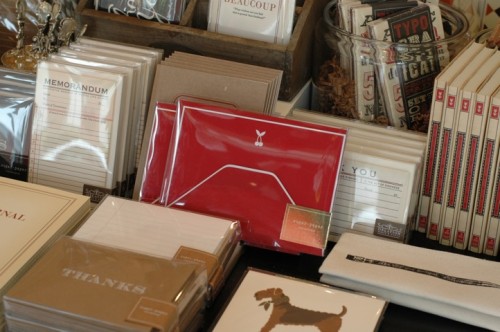While I’m away on vacation I’m running a series of guest posts on the various printing processes, from digital printing to engraving. I’ve asked some designers and printers to share their expertise and lots of photos to fill you in on what you need to know about different stationery printing methods. Today we’re joined by Chelsea and Jamie from Sugar Paper, telling us all about the elegant printing process known as engraving!
Hi OSBP! We’re Chelsea and Jamie from Sugar Paper in Los Angeles, California! At Sugar Paper our first love is (and will always be) letterpress printing. That said, lately we’ve been intrigued by engraving. Anyone who has ever printed on a letterpress knows that printing using white ink is a challenge. If you work and work you can get a subtle image, but there is nothing like engraving for a crisp white image on brightly colored paper.
Luckily, a world renowned engraver is right in our backyard. The oldest engraver in the United States, SF Cooper, is just down the road from us. They recently allowed Jamie and I the opportunity to learn the process, and we’ll show you how it’s done in the images below. We had fun! It was like our own personal Sesame Street field trip. We both loved those Sesame Street segments when we were kids…
What is Engraving?
Like letterpress, the process of engraving imposes ink onto paper under intense pressure, creating images with a unique look and feel unavailable through flat printing. Unlike letterpress, however, type and graphics are raised on each piece of paper. To achieve this result, metal plates are etched with a recessed image. Metal plates are then hand-aligned on the press. Once aligned, the plate is coated with ink and then blotted using kraft paper to clean the plate, leaving only the image with ink remaining. The paper is then hand-fed and each piece is applied under two tons of pressure, creating an embossed image with startling clarity, color purity and depth.
The Printing Process
Like with any labor-intensive printing process, you really have to see the process in action. The images below will help walk you through the engraving process step by step.
The plate is etched with the image and aligned in the press.
White ink is added to the press.
Blotter paper is added to the press to blot the plate between each impression. The entire plate is inked and then blotted with kraft paper to leave only the etched image white.
The pressman feeds each piece of paper and then lines them on a heated conveyer belt to dry.
Caution – Hot! The cards pass through the oven on a conveyer belt. It’s like a conveyer belt toaster oven…
Each card passes through the oven to dry.
The finished cards.
Each set is counted…
and packaged…
Tadaa! The final product is now in stores. Nestled in with some of our other fall favorites from Oblation, Rifle Paper Company and Thomas Paul.
Tips and Advice
The beauty of engraving is best reserved for formal pieces, as the price and the printing style lends itself to more formal occasions.
When having collateral printed these are our tips:
1. Keep in mind that engraving requires longer turn-around times than most printing styles. Engravers are generally old-school printers. This means, they honor traditional printing and paper ordering policies that can delay an order. If you’re in a hurry, this is not the printing method for you. If you have 3 to 4 weeks (or more), you’re golden.
2. Engraving is best used with fine typefaces. The engraving technique captures fine details in a way unparalleled by other printing methods. Shaded type or thin typefaces look terrific when engraved.
3. Engraving is a terrific option for white ink on colored paper. Engraving prints white ink beautifully. The ink sits on top of the paper and creates a bright white color.
4. Two-sided pieces should be avoided when choosing engraving as your printing method. The process of engraving uses water that creates “bruising” on the backside of each piece of paper. The “bruising” would conflict with a two-sided design making the design look muddled. A note: The “bruising” is what creates a distinction between true engraving and thermography the less expensive version of raised printing.
Thank you so much ladies! For more of the fabulous paper wares from Sugar Paper, click here!
Photo Credits: Sugar Paper














Love seeing the process of how things were made.
Thanks!!
love this and LOVE sugar paper! so great to see you guys guest posting 🙂
Chelsea and Jamie! I was just thinking of you and Sugar paper today!!! I love that you are doing this and cannot wait to see what’s next! xoxo